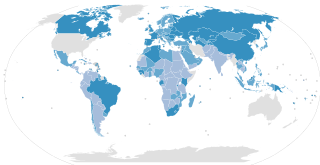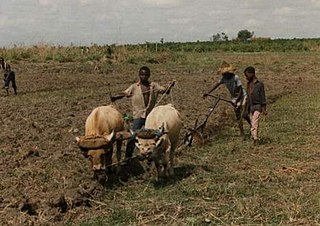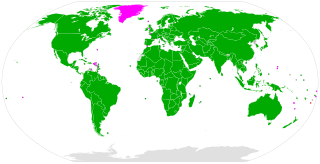The Child Labour Programme of Action is the national plan on elimination of child labour in South Africa. It was provisionally adopted by a large group of key stakeholders in September 2003. These stakeholders include key government departments, including those responsible for labour, education, provincial and local government, water service, justice, policing, prosecution, social development, and education. The lead department is the Department of Labour. It was previously known as the Child Labour Action Programme, but was renamed in February 2006 because of the negative connotation attached to the abbreviation CLAP.
A Child Labour Programme of Action, sometimes called a Child Labour Action Programme or Action Programme on the Elimination of Child Labour (APEC) is a national programme aimed at addressing child labour within a given country. It includes, but is not restricted to, the Worst Forms of Child Labour.
The programme Towards the Elimination of the worst forms of Child Labour (TECL) is a programme on child labour and related issues that is run in all the countries of the Southern African Customs Union (SACU), namely Botswana, Lesotho, Namibia, South Africa and Swaziland.
The Worst Forms of Child Labour Recommendation was adopted by the International Labour Organization (ILO) in 1999 as ILO Recommendation No 190. The provisions of this Recommendation supplement those of the Worst Forms of Child Labour Convention and should be applied in conjunction with them. This article should be read together with that on the Convention.

The ILO Convention concerning Minimum Age for Admission to Employment C138, is a convention adopted in 1973 by the International Labour Organization. It requires ratifying states to pursue a national policy designed to ensure the effective abolition of child labour and to raise progressively the minimum age for admission to employment or work. Convention C138 replaces several similar ILO conventions in specific fields of labour.
A National Action Plan on the elimination of child labour is a national strategy, plan or programme aimed at addressing child labour within a given country, usually with an emphasis on worst forms of child labour. Some countries also refer to this as an Action Programme on the Elimination of Child Labour (APEC).
Child labour in Eswatini is a controversial issue that affects a large portion of the country's population. Child labour is often seen as a human rights concern because it is "work that deprives children of their childhood, their potential and their dignity, and that is harmful to physical and mental development," as defined by the International Labour Organization (ILO). Additionally, child labour is harmful in that it restricts a child's ability to attend school or receive an education. The ILO recognizes that not all forms of children working are harmful, but this article will focus on the type of child labour that is generally accepted as harmful to the child involved.
Child labour in Namibia is not always reported. This involved cases of child prostitution as well as voluntary and forced agricultural labour, cattle herding and vending.
The Worst Forms of Hazards faced by Children at Work is a provision in the Worst Forms of Child Labour Recommendation adopted by the International Labour Organization (ILO) in 1999. It sets out the framework for examining and assessing, "work which, by its nature or the circumstances in which it is carried out, is likely to harm the health, safety, or morals or children".

The World Day Against Child Labour is an International Labour Organization (ILO)-sanctioned holiday first launched in 2002 aiming to raise awareness and activism to prevent child labour. It was spurred by ratifications of ILO Convention No. 138 on the minimum age for employment and ILO Convention No. 182 on the worst forms of child labour.

UCW: Understanding Children's Work is a programme to combat child labour. The 1997 Amsterdam Conference on Combating the Most Intolerable Forms of Child Labour and the 1997 Oslo International Conference on Child Labour both drew attention to the urgent need for concerted global action to end child labour, and called for an expansion of information gathering, statistics and empirical research to help inform this action. The inter-agency programme, Understanding Children’s Work (UCW), was initiated by the International Labour Organization (ILO), UNICEF and the World Bank as one of the responses to the recommendations of the Amsterdam and Oslo conferences. Through a variety of research activities, the UCW Programme supports the partner agencies in improving statistical information on child labour in its various dimensions – its nature, extent, causes and consequences – as well as on what policy approaches are most effective in addressing it.

Child labour in Africa is generally defined based on two factors: type of work and minimum appropriate age of the work. If a child is involved in an activity that is harmful to his/her physical and mental development, he/she is generally considered as a child labourer. That is, Any work that is mentally, physically, socially or morally dangerous and harmful to children, and interferes with their schooling by depriving them of the opportunity to attend school or requiring them to attempt to combine school attendance with excessively long and heavy work. Appropriate minimum age for each work depends on the effects of the work on the physical health and mental development of children. ILO Convention No. 138 suggests the following minimum age for admission to employment under which, if a child works, he/she is considered as a child laborer: 18 years old for hazardous works, and 13-15 years old for light works, although 12-14 years old may be permitted for light works under strict conditions in very poor countries. Another definition proposed by ILO’s Statistical Information and Monitoring Program on Child Labor (SIMPOC) defines a child as a child labourer if he/she is involved in an economic activity, and is under 12 years old and works one or more hours per week, or is 14 years old or under and works at least 14 hours per week, or is 14 years old or under and works at least one hour per week in activities that are hazardous, or is 17 or under and works in an “unconditional worst form of child labor”.
Child Labor in the Philippines is the employment of children in hazardous occupations below the age of eighteen (18), or without the proper conditions and requirements below the age of fifteen (15), where children are compelled to work on a regular basis to earn a living for themselves and their families, and as a result are disadvantaged educationally and socially.
Child labour laws are statutes regulating the work of minors. They are designed to prevent children from work that interferes with the children's ability to attend regular school or that is mentally, physically, socially or morally dangerous and harmful. Child labour helped fuel the Industrial Revolution by being able to access smaller work areas and cheaper labor. Prussia was the first country to enact laws restricting children from working in factories. After Prussia enacted its first laws, other countries followed such as France, England and the United States. The International Labour Organization, ILO, works to set global minimum standards of labour.









